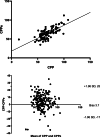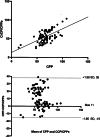Non-invasive estimation of cerebral perfusion pressure using transcranial Doppler ultrasonography in children with severe traumatic brain injury
- PMID: 31996979
- PMCID: PMC7223617
- DOI: 10.1007/s00381-020-04524-7
Non-invasive estimation of cerebral perfusion pressure using transcranial Doppler ultrasonography in children with severe traumatic brain injury
Abstract
Objective: To identify if cerebral perfusion pressure (CPP) can be non-invasively estimated by either of two methods calculated using transcranial Doppler ultrasound (TCD) parameters.
Design: Retrospective review of previously prospectively gathered data.
Setting: Pediatric intensive care unit in a tertiary care referral hospital.
Patients: Twenty-three children with severe traumatic brain injury (TBI) and invasive intracranial pressure (ICP) monitoring in place.
Interventions: TCD evaluation of the middle cerebral arteries was performed daily. CPP at the time of the TCD examination was recorded. For method 1, estimated cerebral perfusion pressure (CPPe) was calculated as: CPPe = MAP × (diastolic flow (Vd)/mean flow (Vm)) + 14. For method 2, critical closing pressure (CrCP) was identified as the intercept point on the x-axis of the linear regression line of blood pressure and flow velocity parameters. CrCP/CPPe was then calculated as MAP-CrCP.
Measurements and main results: One hundred eight paired measurements were available. Using patient averaged data, correlation between CPP and CPPe was significant (r = 0.78, p = < 0.001). However, on Bland-Altman plots, bias was 3.7 mmHg with 95% limits of agreement of - 17 to + 25 for CPPe. Using patient averaged data, correlation between CPP and CrCP/CPPe was significant (r = 0.59, p = < 0.001), but again bias was high at 11 mmHg with wide 95% limits of agreement of - 15 to + 38 mmHg.
Conclusions: CPPe and CrCP/CPPe do not have clinical value to estimate the absolute CPP in pediatric patients with TBI.
Keywords: Cerebral perfusion pressure; Head injury; Non-invasive monitoring; Transcranial Doppler ultrasound; Traumatic brain injury; Ultrasound.
Figures




Similar articles
-
A noninvasive estimation of cerebral perfusion pressure using critical closing pressure.J Neurosurg. 2015 Sep;123(3):638-48. doi: 10.3171/2014.10.JNS14613. Epub 2015 Jan 9. J Neurosurg. 2015. PMID: 25574566
-
Transcranial Doppler as a non-invasive method to estimate cerebral perfusion pressure in children with severe traumatic brain injury.Childs Nerv Syst. 2020 Jan;36(1):125-131. doi: 10.1007/s00381-019-04273-2. Epub 2019 Jul 4. Childs Nerv Syst. 2020. PMID: 31273494
-
Clinical Usefulness of Transcranial Doppler as a Screening Tool for Early Cerebral Hypoxic Episodes in Patients with Moderate and Severe Traumatic Brain Injury.Neurocrit Care. 2020 Apr;32(2):486-491. doi: 10.1007/s12028-019-00763-y. Neurocrit Care. 2020. PMID: 31218643
-
Transcranial Doppler ultrasonography in neurological surgery and neurocritical care.Neurosurg Focus. 2019 Dec 1;47(6):E2. doi: 10.3171/2019.9.FOCUS19611. Neurosurg Focus. 2019. PMID: 31786564 Review.
-
Ultrasound-guided cerebral resuscitation in patients with severe traumatic brain Injury.J Clin Monit Comput. 2023 Apr;37(2):359-363. doi: 10.1007/s10877-022-00954-7. Epub 2022 Dec 1. J Clin Monit Comput. 2023. PMID: 36454340 Review.
Cited by
-
Identifying research activity on brain ultrasonography in craniocerebral diseases by bibliometric and visualized analysis of a 20-year journey of global publications.Medicine (Baltimore). 2025 Mar 21;104(12):e41927. doi: 10.1097/MD.0000000000041927. Medicine (Baltimore). 2025. PMID: 40128044 Free PMC article.
-
Transcranial Doppler Ultrasound, a Review for the Pediatric Intensivist.Children (Basel). 2022 May 16;9(5):727. doi: 10.3390/children9050727. Children (Basel). 2022. PMID: 35626904 Free PMC article. Review.
-
Transcranial Doppler: The Bedside Window to Explore Cerebral Hemodynamics.Indian Pediatr. 2025 Apr;62(4):260-261. doi: 10.1007/s13312-025-00011-x. Indian Pediatr. 2025. PMID: 40126825 No abstract available.
-
Cerebral Hemodynamic Alterations in Dialysis COVID-19 Survivors: A Transcranial Doppler Ultrasound Study on Intracranial Pressure Dynamics.Kidney Dial. 2025;5(2):12. doi: 10.3390/kidneydial5020012. Epub 2025 Apr 3. Kidney Dial. 2025. PMID: 40336917 Free PMC article.
-
An update on pediatric traumatic brain injury.Childs Nerv Syst. 2023 Nov;39(11):3071-3081. doi: 10.1007/s00381-023-06173-y. Epub 2023 Oct 6. Childs Nerv Syst. 2023. PMID: 37801113 Free PMC article. Review.
References
-
- Strauss G, Hansen BA, Kirkgaard P, et al. Liver function, cerebral blood flow autoregulation, and hepatic encephalopathy in fulminant hepatic failure. Hepatology. 1997;25:837–839. - PubMed
-
- Moller K, Larsen FS, Qvist J, et al. Dependency of cerebral blood flow on mean arterial pressure in patients with acute bacterial meningitis. Crit Care Med. 2000;28:1027–1032. - PubMed
-
- Moller K, Qvist T, Tofteng F, et al. Cerebral blood flow and metabolism during infusion of norepinephrine and propofol in patients with bacterial meningitis. Stroke. 2004;35:1333–1339. - PubMed
-
- Newell DW, Aaslid R, Lam A, Mayberg TS, Winn HR. Comparison of flow and velocity during dynamic autoregulation testing in humans. Stroke. 1994;25:793–797. - PubMed
MeSH terms
LinkOut - more resources
Full Text Sources
Medical

